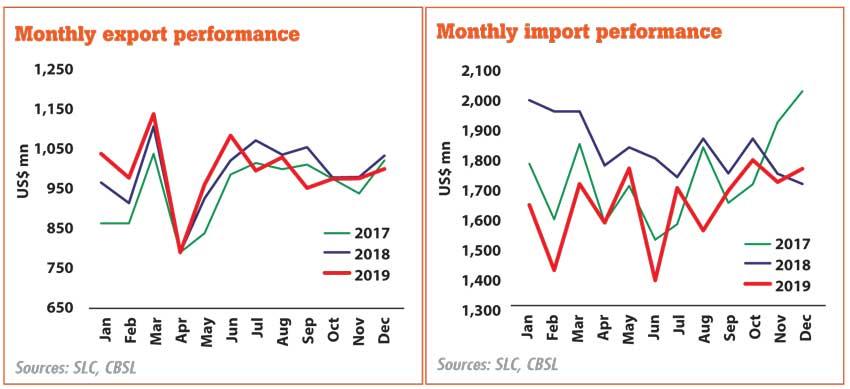18 Feb 2020 - {{hitsCtrl.values.hits}}

Sri Lanka’s imports picked up in December 2019, first time since October 2018, most likely responding to the economic stimulus package announced end-November by the newly formed government of President Gotabaya Rajapaksa.
The expenditure on imports in December 2019 rose 2.9 percent year-on-year (YoY) to US $ 1,784 million, as the expenditure on consumer goods imports, both food and non-food, rose 9.5 percent YoY to US $ 390.9 million.
The expenditure on personal motor vehicle imports rose first time since November 2018 by 8.6 percent YoY to US $ 83.9 million, “mainly reflecting the impact of the resumption of personal motor vehicle imports under concessionary permits,” the Central Bank said.
The expenditure on investment goods imports increased in December 2019, due to the higher imports of machinery and equipment and transport equipment.
The government slashed both personal and corporate taxes and announced credit support for the country’s struggling small and medium-sized enterprises (SMEs) by way of a 12-month moratorium on their debt, in a bid to revitalise the stalled economy.
On top of that, the Central Bank in January cut the key policy rates by 50 basis points, highlighting the need to support a recovery in domestic growth in the backdrop of favourable inflation outlook.
However, Sri Lanka’s total merchandise imports in 2019 fell 10.3 percent YoY to US $ 19.93 billion, allowing the country to narrow its trade balance to US $ 7,997 million in 2019, from US $ 10,343 million in 2018.
However, the December 2019 trade gap widened to US $ 784 million, from US $ 781 million a year ago.
Meanwhile, Sri Lanka’s exports remained flat during 2019, as the country was able to increase its export income by mere 0.4 percent to US $ 11.9 billion, compared to the previous year, according to the data released by the Central Bank yesterday.
Sri Lanka’s export basket hasn’t changed for a long time and apparel accounts for about 45 percent of the country’s merchandise exports.
The income from exports in December 2019 fell 3.2 percent YoY to US $ 1 billion, amid a decline in agricultural and industrial exports.
Textile and garment exports in December 2019 fell 2.1 percent YoY to US $ 483.2 million.
However, in cumulative terms, textile and garment exports grew 5.2 percent YoY to US $ 5,596.5 million in 2019.
Agricultural exports in December 2019 fell 9.8 percent YoY to US $ 195.4 million, as tea exports fell 9.6 percent YoY to US $ 105.8 million. Seafood exports also fell 18.3 percent YoY to US $ 23.9 million.
Sri Lanka’s total agricultural exports fell 4.6 percent YoY to US $ 2, 461.9 million in 2019, amid tea exports falling 5.7 percent YoY to US $ 1,364.4 million.
The earnings from tourism and workers’ remittances, two major inflows to the country’s current account, fell during 2019, according to the provisional data of the Central Bank.
The tourism earnings were provisionally estimated at US $ 3,592 million in 2019, down from US $ 4,381 million a year ago. The December 2019 tourism earnings were estimated at US $ 454 million, down from US $ 475 million. The workers’ remittances recorded a growth of 13.8 percent YoY in December 2019, amounting to US $ 665 million. But on a cumulative basis, the workers’ remittances recorded a decline of 4.3 percent YoY to US $ 6,717 million in 2019, compared to US $ 7,015 million in 2018.
Meanwhile, a net outflow of foreign investment amounting to US $ 100 million was recorded in the rupee-denominated government securities market in December 2019, resulting in a cumulative net outflow of US $ 334 million in 2019.
During the month of December 2019, there was a net foreign outflow of US $ 5 million from the Colombo Stock Exchange (CSE), including the primary and secondary market transactions.
On a cumulative basis, the CSE recorded a net outflow of US $ 35 million in 2019.
Further, the net inflows on account of long-term loans to the government amounted to US $ 8 million during December 2019.
Sri Lanka’s gross official reserves stood at US $ 7.6 billion at end-December 2019, equivalent to 4.6 months of imports.
The Sri Lankan rupee remained stable in December 2019 and appreciated by 0.6 percent against the US dollar, during the year 2019.
The currency appreciated by a further 0.1 percent against the US dollar during the year up to February 17, 2020.
16 Nov 2024 40 minute ago
16 Nov 2024 55 minute ago
16 Nov 2024 1 hours ago
16 Nov 2024 1 hours ago
16 Nov 2024 1 hours ago